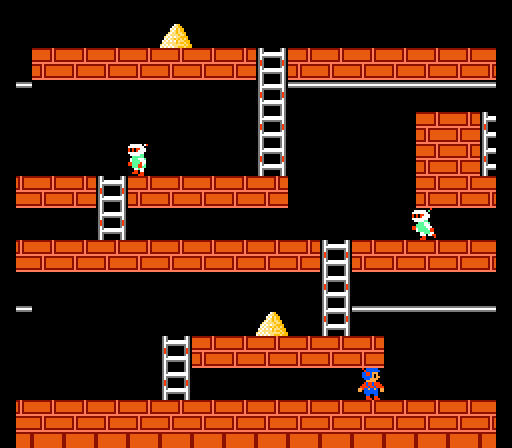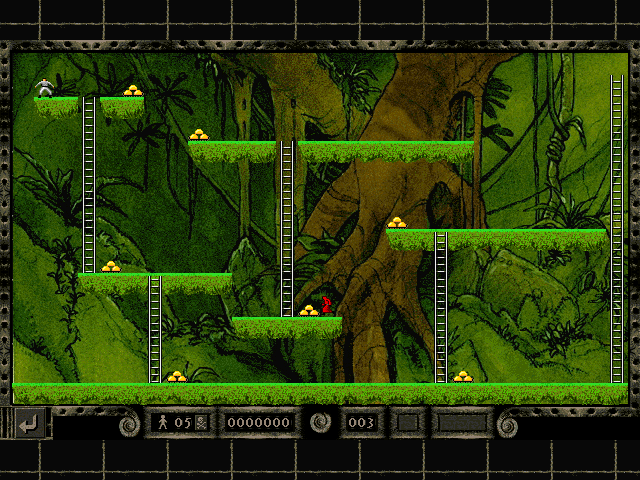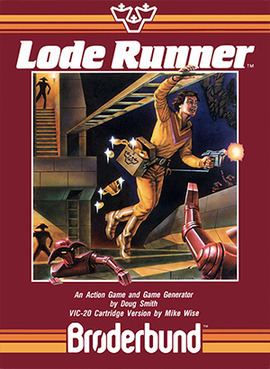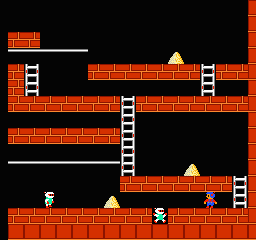8.2 /10 1 Votes8.2
3.7/5 Google Play Initial release date 1983 | 4.5/5 Emuparadise Mode(s) Single-player Designer Douglas E. Smith | |||||||||||||||||||||||||||||||||
 | ||||||||||||||||||||||||||||||||||
Genres Platform game, Puzzle video game Similar Hudson Soft games, Platform games | ||||||||||||||||||||||||||||||||||
Lode runner nes 1984 complete game stage 1 stage 10
Lode Runner is a platform video game first published by Brøderbund in 1983. Unlike later platformers which rely on precision jumping and movement, levels in Lode Runner are puzzle-oriented. It is one of the first games to include a level editor, a feature that allows players to create their own levels for the game. This feature bolstered the game's popularity, as magazines such as Computer Gaming World held contests to see who could build the best level. Tozai, Inc. currently holds the intellectual property and trademark rights of Lode Runner.
Contents
- Lode runner nes 1984 complete game stage 1 stage 10
- Lode runner apple ii video game years 1984
- History
- Basics
- Enemy AI
- Permitted contact
- Trapping and using guards
- Traversal orders
- Timing
- Reception
- Series
- Arcade
- 1990s
- Xbox Live Arcade
- Lode Runner Classic
- Related games
- Similar games
- References

Lode runner apple ii video game years 1984
History

The prototype of what later became Lode Runner was a game developed by Douglas E. Smith of Renton, Washington, who at the time was an architecture student at the University of Washington. This prototype, called Kong, was written for a Prime Computer 550 minicomputer limited to one building on the UW campus. Shortly thereafter, Kong was ported to VAX minicomputers, as there were more terminals available on campus. The game was programmed in Fortran and used ASCII character graphics. When Kong was ported to the VAX, some Pascal sections were mixed into the original Fortran code.

Over one weekend in 1982, Smith was able to build a crude, playable version in 6502 assembly language on an Apple II+ and renamed the game Miner. Through the end of the year, he refined that version, which was black-and-white with no joystick support. He submitted a rough version to Brøderbund around October 1982 and received a one-line rejection letter in response to the effect of "Thank you for submitting your game concept. Unfortunately it does not fit within our product line.".

Smith then borrowed money to purchase a color monitor and joystick and continued to improve the game. Around Christmas of 1982, he submitted the game, now renamed Lode Runner, to four publishers and quickly received offers from all four: Sierra, Sirius, Synergistic, and Brøderbund. He took the deal with Brøderbund.

Miner, like its text-based Kong predecessors, had only very simple animation where characters move across the screen in block increments. It was too primitive for an acceptable commercial product as Brøderbund wanted detailed pixel-level movement. According to this article, Smith was given a $10,000 advance by Brøderbund to develop the inter-square animation, and to provide 150 levels of play. In a 2010 interview, game designer John Romero claimed that Smith added the level editing function at the request of neighborhood kids he had testing the game, and "a ton" of the levels they designed ended up in the final game. It would be one of the first video games to include a level editor.

The game was released in mid-1983. The original microcomputer versions included the Apple II series, the Atari 8-bit family, the Commodore VIC-20, the Commodore 64, and the IBM PC. Of these, all versions besides the VIC-20 were on diskette, but the Commodore 64 also got a cartridge version with only 32 levels and no editor for users without disk drives. The VIC-20 port was cartridge only but did include a level editor which supported saving to either disk or cassette. The IBM version was originally on a self-booting disk; it is incompatible with video cards other than CGA. A later DOS rerelease appeared in 1986 which runs on any video card.
A port for the original 128k Macintosh followed in 1984; it will run on machines up to OS 6 and can also be used on System 7 with a patch. Other versions include those for the Atari ST, Sinclair Spectrum 48K/128K, a licensed version for the MSX computer published by ASCII Corporation, Sega SG-1000, NES, Windows 3.1, Macintosh, and the original Game Boy.
The NES version was released by Hudson Soft in 1984 (North American release 1986) and became one of the earliest third-party games made for that system. It had 50 levels, scrolling screens, added music, and graphics redone in a more cartoon-like style. In addition, fruits and vegetables randomly appear which may be grabbed for additional points. Although a level editor was included, there is no way to save levels created with it. An arcade game of Lode Runner was produced with some added features like the ability to hang off the ends of ladders and an improved enemy AI.
Brøderbund released a special enhanced version, Championship Lode Runner, in 1985. It only had 50 levels, but with much higher difficulty than the original. The company offered a commemorative certificate to anyone who could submit proof of having beaten the entire game (and submitted proof of purchase to show that their copy of the game was not pirated). It was ported to the Apple, Atari, C64, MSX, and PC, as well as the NES (although that version did not reach North America).
The Atari 8-bit version of Lode Runner was converted to cartridge and re-released by Atari Corporation in 1987, as one of the series of releases for the Atari XEGS console. This version contained all 150 levels and the level editor, which required a disk drive.
Basics
The player controls a stick figure who must collect all the gold in a level while avoiding guards who try to catch the player. After collecting all the gold, the player must touch the top of the screen to reach the next level. There are 150 levels in the game which progressively challenge players' problem-solving abilities or reaction times.
Levels feature a multi-story, brick platform motif, with ladders and suspended hand-to-hand bars that offer multiple ways to travel throughout. The player can dig holes into floors to temporarily trap guards and may safely walk atop trapped guards. Should a guard be carrying a bar of gold when he falls into a hole it will be left behind, and can be retrieved by the player. Over time, floors dug into will regenerate, filling in these holes. A trapped guard who cannot escape a hole before it fills is consumed, immediately respawning in a random location at the top of the level. Unlike guards, the player's character may not climb up out of a hole, and will be killed if it fills before he can escape by other means. Floors may also contain trapdoors, through which the player and guards will fall, and bedrock, through which the player cannot dig.
Notably, the player can only dig a hole to the sides, and not directly underneath himself. This introduces an important strategy for when digging a hole x blocks deep, the player must first dig a gap at least x wide to be able to dig through it, as the number of spaces will shrink with each layer, and the player needs at least one free adjacent space to be able to dig. However, exceptions to this rule arise when the player digs from the position of standing on a ladder, or hanging from a hand-to-hand bar, which allows the player to repeatedly dig and descend one row. This kind of digging is involved in solving many of the levels.
The player starts with five lives; each level completion awards an extra life. Should a guard catch the player, one life is subtracted, and the current level restarts. The player's character can fall from arbitrary heights without any injury but cannot jump, and players can trap themselves in pits from which the only escape is to abort the level, costing a life, and begin again.
Enemy A.I.
The guards do not simply home in on the player by always taking the shortest path, but also move in counter-intuitive ways according to a strange algorithm. This is a key factor in game logic, especially in the advanced levels, where exploiting the behavior of the guards is essential toward attaining the solution. Sometimes, when the player and a guard are on the same ladder, for instance, the guard will move away from the player. In general, depending on the exact positioning relative to Lode Runner, the guards sometimes appear to be repelled. The behavior is far from random, however. A big part of mastering the game involves developing the intuition to predict the movement of the guards.
Permitted contact
The player may come into contact with a guard directly from above, with the stick figure's feet touching the guard's head. This is what enables the player to walk over guards who are temporarily stuck in a hole that has been dug. It is also possible to make this contact while both the guard and the player are in free fall, since the player not only runs faster than the guards, but also falls faster; moreover, it is possible to survive the feet-to-head contact while a guard is standing on a platform and begins to move. Both forms of contact are necessary to solve some levels. Sometimes it is necessary to liberate a trapped guard by digging while standing on his head, but then moving rapidly in the opposite direction when the guard begins marching to freedom. In a few levels, it is necessary to use a falling guard as a bridge to reach an otherwise unreachable area. One subtlety is that if a down movement is initiated while standing on a guard's head, or briefly touching the guard's head during free fall, the consequences are fatal.
Trapping and using guards
In some levels, guards can be deliberately trapped in various ways. For instance, they can be lured into entering a part of the level from which there is no escape. In some situations, the player can liberate trapped guards by digging them out. In some levels, to collect some gold pieces, the player must exploit the guards into collecting gold pieces, because they are positioned such that whichever figure collects them will become trapped. When the guard collects the piece and becomes trapped, the player can release the guard and then later steal the gold when the guard drops it or falls into a hole.
In some levels, there are gold pieces which can only be collected by killing guards by trapping them in dug holes which close up. Deceased guards come back to life from locations near the top of the screen, which may allow them to reach parts of the level that cannot be reached by the player.
Traversal orders
Some levels require careful ordering of traversal, because they are divided into zones connected by passages which are impossible to traverse in the reverse direction. If a gold piece remains in an unreachable zone, the player may have to abort the level to start again, losing a life, unless there is a way to coax a guard into bringing the gold.
Timing
Some of the game's puzzles in the advanced levels are time-sensitive. The player must dig in order to penetrate the interior of some cavern to collect gold, and quickly return the same way before the digging repairs itself, enclosing Lode Runner in that cavern with no means of escape.
Some puzzles require deliberate timing among the digging actions because Lode Runner must run over previously dug-out tiles that have just repaired themselves, while having enough time to pass through ones which have not yet repaired.
Reception
Lode Runner was very successful. It was Broderbund's second best-selling Commodore game as of late 1987.
Softline in 1983 praised the game, calling it "smooth, thoughtful, and quite addictive". The magazine approved of its large number of unique levels, level editor ("the possibilities are astounding"), and emphasis on "wits and strategy" over violence. Computer Gaming World praised Lode Runner's particularly easy-to-use level editor and the strategy involved for an arcade title, describing it as "one of the few thinking men's arcade games". Praises for the introduction of strategy into the "climbing game" genre and for the intuitive level editor were repeated in Video magazine's review of the game as well as praise for its graphics and animation, with the Apple II version being described as "stand[ing] out far ahead of the pack".
In 1984 Lode Runner was awarded "1984 Computer Game of the Year" at the 5th annual Arkie Awards. Judges praised its "outstanding design", and described it as "fascinating", "irresistible", and as "the thinking player's climbing conquest". Ahoy! called the game "a top-notch action game that requires both a quick mind and an agile joystick". With the "easy-to-use game generator", the magazine concluded that "Lode Runner is one of the best games available for the C-64. Unconditionally and wholeheartedly recommended". PC Magazine gave the game 16.25 out of 18 points. It called the game "a tour de force of American ingenuity ... the first release in a long, long time that can honestly bear the title, 'computer game' ... Lode Runner uses the power of the PC to create something much more than a video version of Ping Pong. This game requires thought, too". The magazine praised the IBM PC version's graphics, increasingly difficult level design, and the level editor.
By 1985 the game was still selling well, with Video magazine reporting that it was the 6th best-selling recreational title in both March and April of that year. Zzap!64 in 1985 called the Commodore 64 version "not one of the most recent games but certainly one of the best ... a classic for a long time to come ... graphically minuscule and aurally crude, the game's sheer addiction kept my eyes propped open until the owls went to bed". Orson Scott Card wrote in Compute! that Lode Runner's editor was the first game that let him and his family express their creativity through gaming.
In 1984 Softline readers named Lode Runner the most popular Apple and fourth most-popular Atari program of 1983. The Spectrum version of the game was voted number 37 in the Your Sinclair Official Top 100 Games of All Time. GameSpot named Lode Runner as one of the "Greatest Games of All Time". Time rated Lode Runner #1 game in "The 10 Greatest Games for the Apple II" list.
Tetris designer Alexey Pajitnov claimed it to be his favorite puzzle game for many years.
Series
Over the years, a series of Lode Runner games have been developed for numerous systems, including Commodore 64, MSX, Atari ST, Electronika BK, PC-8001, PC-6001, X1, FM-7, SG-1000, Atari 400/800, PC-9801, DOS/Windows, ZX Spectrum, Mac OS, Amstrad CPC, NES, Game Boy, BBC Micro, Nintendo DS, PlayStation, Virtual Console, Xbox 360 (XBLA), iPod and Android.
An unreleased version of the game for the Atari Lynx was discovered in 2008 on an old Atari Corp. hard drive.
A Lode Runner board game was designed by Doug Carlston and published by Tsukuda in 1986.
Arcade
In 1984, Irem developed an arcade conversion of Lode Runner. It contained 24 remixed levels from the 150 original levels. Irem brought many of their arcade inspired levels to the Famicom Disk System under the names Super Lode Runner and Super Lode Runner II. The arcade version had numerous sequels, including:
1990s
Several versions of Lode Runner were not released in the U.S., such as Lode Runner Twin and Power Lode Runner (1999, SFC), which vary gameplay, mostly by adding different characters and scenarios. Another title, Battle Lode Runner, was originally exclusive to Japan, but made available on 23 April 2007 as the first Japan-only game to appear on Nintendo's Virtual Console service. The original Lode Runner followed in June 2007. There is also a Cubic Lode Runner, a 3-D Lode Runner variant released only in Japan for the Nintendo GameCube and PlayStation 2.
The NES version, developed by Hudson Soft, marked the first appearance of Bombermen as the opposing robots. The end screen to Bomberman for the NES notes that the original White Bomberman has turned human and hints at his appearance in another game, with the Lode Runner behind him. In the Japanese version, the reference is more direct: "Congratulations - Bomber Man becomes Runner - See you again in Lode Runner."
In Japan, the Famicom version of Lode Runner allows editing and creating levels to share with friends using a Famicom Data Recorder.
Hudson Soft also announced a version of Lode Runner for the Nintendo DS and released in 2006.
Xbox Live Arcade
On January 7, 2008, a remake of Lode Runner, developed by Tozai and Southend Interactive, was announced at CES '08, and was released on April 22, 2009. The game features revamped 3D graphics, additional game modes, cooperative and competitive multiplayer support, six new block types and a level editor, as well as Live leaderboards and a timeline of the game's history.
Lode Runner Classic
Lode Runner Classic was made available as an Xbox Live enhanced game for Window Phone 7 series of phones on July 18, 2012. It features the graphics, gameplay and 150 levels from the original Lode Runner game. On January 17, 2013, Lode Runner Classic was released for both the iOS and Android.
Related games
The game is an example of the trap-em-up genre, which also includes games like Heiankyo Alien, Boomer's Adventure in Asmik World, and Space Panic.
Brøderbund referred to the game's guards as members of the Bungeling Empire, enemies common to Choplifter, the Lode Runner series, and Raid on Bungeling Bay.
Brøderbund also released Spelunker for arcade machines, Atari 8-bit, Commodore 64, MSX and Nintendo Entertainment System.
